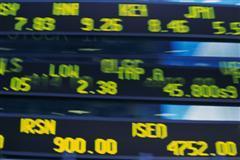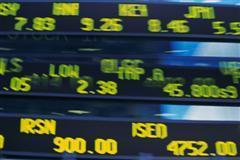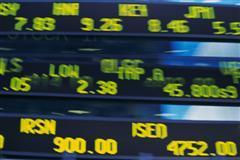| Home | About | Archives | RSS Feed |

@the Market: What Will the New Year Bring?
 |
Now that we have safely tucked away the year 2010 with the S&P 500 Index up 12.9 percent, will we enjoy a similar or better return in 2011? Clearly, the majority of investors are looking for another up year. I believe that’s a safe bet, at least for the first half of the year.
Since March of 2009, I have been forecasting an up market and have been correct in doing so. Sure, during that time period we have had our ups and downs largely based on worries of a "double dip" recession here in the U.S. and financial problems in Europe. I discounted both events but also warned investors that the markets would react negatively. I considered those sell offs a buying opportunity. In hindsight, where I have erred was in estimating the severity and duration of some of these pullbacks.
For example, I did identify an interim top in the markets back in April (at around the S&P 500 1,220) but was too bearish in estimating the index would decline to 950 before the correction would be over. Instead, the S&P 500 tested and re-tested the 1,035 level and then resumed its climb in September.
The low in the markets coincided with The Federal Reserve’s announcement that they planned to launch a second quantitative easing. It was enough to reverse my cautious stance, admit my mistake, and turn positive on the markets. I have been bullish since the fall and have no reason to change my mind now that we are entering the New Year.
I believe the economy will hold positive surprises for us in the first half of the year. Growth will exceed most economists’ forecasts and although unemployment will remain high, we will see a steady improvement over the next several months as American corporations hire more workers. The housing market will also surprise us as well. I firmly believe 2010 saw the bottom in housing prices and sales. In 2011, we should see a small but steady improvement in all but the most bombed-out housing markets. The Fed will stay accommodative as well keeping short-term rates low and equities higher.
All this good news should translate into higher prices in global stock markets and in commodities. The S&P 500 could see gains of 15 percent-plus before the year is over and depending upon your investments, that gain could be substantially higher. However, we will still be subjected to corrections. Right now, for example, as a result of this Christmas rally, all three indexes are over extended and in need of a pullback. This could occur as early as next week or later in the month. These mini-corrections are an inevitable cost of doing business in equity
There is also a distinct possibility that later in the year the stock market will get ahead of itself. After all, markets vacillate between fear and greed. As the averages trend higher, investors tend to believe markets will go higher still. Valuations get out of whack or events occur that change the game and the markets correct. So don’t be surprised if I sound a note of caution as early as this spring. Rest assured that somewhere out there lurks another substantial pullback (greater than 10 percent). Hopefully, I will be on the job and lucky enough to identify it when it occurs.
However, for now, I see clear sailing ahead with only a few minor squalls in the stock markets. As for fixed income, clearly, interest rates have seen their lows in the U.S. Treasury and Municipal bond markets. That multi-decade Bull Run is over and investors would be well advised to steer clear of those areas. Commodities will continue to gain although this year I suspect precious metals will take a back seat to their more mundane cousins such as agricultural products, base metals and materials.
All in all, I feel as positive about the markets now as I did at this time last year. I guess the difference today is that I am expecting more people to enjoy the benefits of an economic expansion than ever before. And that is a real reason to celebrate, so happy New Year to you and yours.
Bill Schmick is an independent investor with Berkshire Money Management. (See "About" for more information.) None of the information presented in any of these articles is intended to be and should not be construed as an endorsement of BMM or a solicitation to become a client of BMM. The reader should not assume that any strategies, or specific investments discussed are employed, bought, sold or held by BMM. Direct your inquiries to Bill at 1-888-232-6072 (toll free) or e-mail him at wschmick@fairpoint.net. Visit www.afewdollarsmore.com for more of Bill's insights.
| Tags: forecast |
@theMarket: Santa Visits Wall Street
 |
As markets close in this holiday-shortened week, the stock market enjoyed its annual Christmas rally with all three averages reaching new highs for the year. It was the best December for the S&P since 1991 and most forecasters believe these gains indicates an even larger move in the first half of next year.
Goldman (or should I say Government) Sachs upped its forecast for the S&P 500 Index to 1,450 for 2011. That is a 16 percent projected gain in the index and, if true, would bring us within 115 points of that average's all time high reached on Oct. 9, 2007.
Adding to the good cheer this week was the news that existing home sales gained 5.6 percent in November, which kindled hopes that the long-awaited recovery in the housing market was at hand. But in my opinion, the real Santa Claus this year came disguised as the Federal Reserve Bank and its chairman, Ben Bernanke.
Back in late August, when the first public statements from the Federal Reserve Bank surfaced on the possibility of a second quantitative easing, the stock market snapped out of its doldrums. I immediately abandoned my cautious stance and both stock and commodity prices started to move higher and have never looked back.
Most market watchers argue that QE II is a failure judging by the results in the bond market. They point to medium and long-term interest rates that have actually increased over the last two months as evidence that QE II has failed. I beg to differ. I believe the Fed's intention was focused solely on keeping short-term interest rates at a historical low level and the steepening of the yield curve (where long rates are higher than short rates) was exactly what they wanted.
In economics class, I learned that a steepening yield curve is synonymous with a growing economy, but as the economy grows so does the threat of inflation. Maybe not at first, but as time progresses, the economy grows stronger and begins to overheat. The specter of rising inflation becomes almost certain. Investors who understand this begin to demand higher yields now from the bond market, especially from those who are selling long-term bonds, say 10 to 30 years out.
Now consider those millions of risk-adverse investors who have put their money into long-term treasury bonds as the result of the recession and financial crisis. They are losing their shirt right now as their investments drop in price on almost a daily basis. Sure, they can sell and buy shorter term government maturities or CDs that promise to yield next to nothing for "an extended period of time" or they can move back into the stock market.
Most investors know that they can get a higher return in the stock market than in the bond market. But until recently, they were too frightened to risk their money in an economy and a stock market that might roll over at any moment. However, thanks to QE II, commodities (an inflation play) and stocks have been roaring back to life on the heels of progressively positive economic data that promises to just get better and better.
So with bond prices down, equity and commodity prices up, and with the Fed on record as wanting the stock market higher and you now have the ingredients guaranteed to entice even the most wary individual back into the stock market. In addition, a steeper higher yield curve is actually good for the traditional players in the bond market - pensions, endowments and insurance companies.
These entities receive constant inflows of new cash because of the nature of their businesses. Investing this money in higher long term rates makes it far easier for them to meet their future obligations. It is also great for the banks that borrow short term and lend long term. With higher long term rates, the Fed is betting that even the banks may be attracted to this higher profit spread and reconsider their present stingy policy toward lending.
So all in all, the Fed has accomplished a great deal with QE II, contrary to popular opinion. And like Santa Claus, no one actually catches the bearer of this gift even if it is sitting there, big as life, under the tree.
Bill Schmick is an independent investor with Berkshire Money Management. (See "About" for more information.) None of the information presented in any of these articles is intended to be and should not be construed as an endorsement of BMM or a solicitation to become a client of BMM. The reader should not assume that any strategies, or specific investments discussed are employed, bought, sold or held by BMM. Direct your inquiries to Bill at 1-888-232-6072 (toll free) or e-mail him at wschmick@fairpoint.net. Visit www.afewdollarsmore.com for more of Bill's insights.
| Tags: rally, QEII, inflation |
@theMarket: Overhead Resistance Keeps Markets in Check
 "I don't get it," gripes an investor who called from Chicopee, "Congress goes and passes the tax-cut extensions, which is good news, right, and still the market does nothing. What gives?"
"I don't get it," gripes an investor who called from Chicopee, "Congress goes and passes the tax-cut extensions, which is good news, right, and still the market does nothing. What gives?"
By way of explanation, pundits argue that the passage of this event was already "baked in" to the averages, which is why the markets are trading close to the year's high. OK, I'll take that on board but there has been a lot of good news lately that should not have been discounted — higher consumer confidence, less unemployment, greater factory output — but the market appears uninterested. The much-heralded Christmas rally has stalled just below a key resistance area at 1,250 on the S&P 500 Index. So maybe we have hit the highs for this year already.
Last week, I wrote that it wouldn't surprise me if we saw a 50-75 point pullback in the S&P Index. I opinioned that the catalyst might be a congressional failure to pass the tax cut extensions. Although the extensions were passed, the markets still look like they would rather go down than up in the short term.
That is surprising since my friend in Chicopee is right. The latest government initiative could add somewhere between 0.50 percent to 1 percent to 2011 GDP. That is nothing to sneeze at so maybe fundamental analysis is not the place to look for an answer.
Technically most stocks, sectors and commodities are overextended. In order to correct that condition, the averages need to back and fill for a period of time or a market pullback is in order.
In addition, whenever markets approach a big technical area of resistance like 1,250, there is usually a battle of wills between the bulls and the bears. So why is 1,250 such an important number?
Readers may recall that by September 2008, Bear Sterns had already collapsed as had Fannie Mae and Freddie Mac, our two quasi-governmental mortgage giants. The House of Lehman Brothers was about to fall and that's when the S&P first broke 1,250 (on Sept. 3). It traded back and forth with a great deal of volatility around that level until Sept. 23 when it finally gave up the ghost and plummeted 48 points. Suffice it to say that the 1,250 level was not easily conceded by the bulls and what had once served as strong support for the markets, once broken, now also serves as an important resistance point in the index's attempt to move higher.
The process of testing that resistance level is what is occurring right now. My guess is that the bulls will ultimately win that struggle but not without a fight. I do not believe we will see the massive percentage point swings that we suffered through in 2008 but a milder, less dramatic give and take that could last for another week or so.
Whether the ongoing problems within the European financial sector will furnish the excuse the bears will need for a pullback remains to be seen. Higher interest rates over in the government bond market or a big move in the dollar could also spook investors. Regardless of the reason, I would be adding equity to my portfolio on any dip.
Bill Schmick is an independent investor with Berkshire Money Management. (See "About" for more information.) None of the information presented in any of these articles is intended to be and should not be construed as an endorsement of BMM or a solicitation to become a client of BMM. The reader should not assume that any strategies, or specific investments discussed are employed, bought, sold or held by BMM. Direct your inquiries to Bill at 1-888-232-6072 (toll free) or e-mail him at wschmick@fairpoint.net. Visit www.afewdollarsmore.com for more of Bill's insights.
| Tags: market, swings, bulls |
@theMarket: Markets Held Hostage by Congress
 Although the week started off on a positive note with the president announcing a potential deal on extending the Bush tax cuts, by the end of the week investors grew a bit more cautious. All eyes were on the politicians in Washington. As the spotlight falls on this lame-duck Congress, our elected officials are wringing as much publicity as possible from this opportunity before seriously negotiating this tax extension.
Although the week started off on a positive note with the president announcing a potential deal on extending the Bush tax cuts, by the end of the week investors grew a bit more cautious. All eyes were on the politicians in Washington. As the spotlight falls on this lame-duck Congress, our elected officials are wringing as much publicity as possible from this opportunity before seriously negotiating this tax extension.
On Thursday, it was the Democrats' turn to huff and puff about the deal their president cut with Republicans to prevent a huge tax hike on all Americans on Jan. 1. Democratic congressmen claimed that extending the cuts for the wealthy were against their ideals, as if wealthy taxpayers were somehow no longer Americans. But we are told not to fear since just about every forecaster in the country believes that despite this political grandstanding, a bill to extend the tax cuts will pass by Christmas. I certainly hope that will happen but I can't help feeling a disturbing sense of deja vu around the issue.
Do you remember the congressional antics during the $700 billion financial bail out plan when it was first brought up for a vote in September 2008? Preceding that vote, most pundits on Wall Street couldn't imagine it would fail to pass. After all, the financial system was disintegrating, world stock markets were melting down and no one out there had any other plan to stop the world's descent into financial oblivion. Yet, Congress failed to pass the measure. The Dow plunged 7 percent that day and continued to fall until those dimwits in Washington finally realized that regardless of their ideals, it was a bailout or the end of line for all of us.
The point is that we better get a bill passed by the end of next week or we could see a quick 50-75 point sell-off in the S&P 500 Index with corresponding drops in the other indexes.
There has been a spate of good news this week from a surprise drop in the U.S. trade deficit to continued improvement in the initial jobless claims and yet the markets have responded half-heartedly to this good news. Instead, they are hanging on every word that the politicians utter.
Meanwhile, over in the bond market, interest rates on intermediate and long-term U.S. Treasury bonds are beginning to rise. That has also contributed to the market's worries. I have written on several occasions that we were in the ninth inning of this bull market in bonds and if you are not already out of those instruments you should really consider doing so and now. This rise in rates is also attracting new interest in the dollar, which is bearish for commodities, but it is a bullish sign that the economy is growing. As a result, increasing numbers of investors are gravitating toward the stock markets.
It is no surprise that most of the brokers on Wall Street are ratcheting up their forecasts for the S&P 500 for next year. This week most strategists have raised their target to the 1,425-1,450 level. That would be a whopping 20 percent increase from today's levels. I have no problem with those forecasts because I believe they are entirely doable.
What may change are the sectors and types of stocks that lead the markets during the coming year. Large cap stocks, for example, have lagged the market since this rally began in March 2009. There are some early signs that investors may be rotating into this space. Will commodities continue to outperform? I don't think so, at least over the next few months.
Silver, gold, oil and other commodities are closing in on my price targets (see my column "Hi Yo Silver"). They are due for a healthy (and long overdue) consolidation, possibly on the back of a rising dollar.
In any case, the markets are going higher with or without a sudden, Washington-inspired dip. For long-term investors, that's all you need to know.
Bill Schmick is an independent investor with Berkshire Money Management. (See "About" for more information.) None of the information presented in any of these articles is intended to be and should not be construed as an endorsement of BMM or a solicitation to become a client of BMM. The reader should not assume that any strategies, or specific investments discussed are employed, bought, sold or held by BMM. Direct your inquiries to Bill at 1-888-232-6072 (toll free) or e-mail him at wschmick@fairpoint.net. Visit www.afewdollarsmore.com for more of Bill's insights.
| Tags: stock market, tax cuts |
@theMarket: Break Out
 It would appear that November's pull back in the stock market is over. From top to bottom, the S&P 500 Index lost 4.5 percent and regained 3 percent of that in just the last two days. That feels to me like a break out.
It would appear that November's pull back in the stock market is over. From top to bottom, the S&P 500 Index lost 4.5 percent and regained 3 percent of that in just the last two days. That feels to me like a break out.
Having gone from oversold to overbought in less than one week, I would suspect that a small dip in the averages is warranted, but that would only be an opportunity to buy in my opinion. Last week, I advised investors not to be too worried about last week's sell-off. I had a hunch that new data would indicate that the economy is improving. That turned out to be the case. I expect a continued stream of better news on the economy over the next few months that will surpass most investor's expectations.
In my last column, I wrote that "the only possible fly in the ointment I see right now is the failure of Congress to act on the looming expiration of the Bush tax cuts." I implored readers to put their legislators on notice that the tax-cut extensions were their No. 1 priority. Washington must have been reading my columns because on Monday morning both parties met and began working on that extension. With luck, it looks like a compromise could be reached before Christmas.
At the same time, the president's deficit reduction team presented a variety of far-reaching ideas to cut the deficit (see Thursday's column "And Now for That Deficit"). Between those developments stateside, plus the potential bailout of Ireland as well as some strong industrial production numbers from China, set us up for a rally.
Although we have yet to break above April's highs in the S&P 500 Index, over on the NASDAQ we have breached that barrier, as has the Dow. The consumer discretionary, industrial, energy and materials sectors have all broken out to bull market highs as well this week. These sectors all appear to be in a solid uptrend, despite looking a bit extended on a short term basis. Financials continue to move sideways as do some of the more defensive sectors such as utilities, health care, consumer stables and telecom.
Bullish sentiment has also been rising but is still below 50 percent, although next week's figure from the American Association of Individual Investors may show a bigger increase after this recent rally. As a contrarian indicator, bullish sentiment is not yet at worrisome levels.
Remember too that the bulls have the wind at their backs. The economy is growing, (despite the high unemployment rate) as businesses begin to invest in plant and equipment. Although the housing market is bumping along the bottom, it is at least stabilizing, and exports are growing thanks to the weakening dollar. Finally remember that Fed Chairman Ben Bernanke is on record in wanting stock prices higher (see "Don't Fight the Fed" ). All in all, that is a powerful combination that should drive the markets higher. How high?
On the S&P 500 Index 1,300 is a good round number. That's a potential gain that might even entice some of those investors sitting in bonds to come out and play in the equity markets. As for where I see the most potential gains: emerging markets, mines and metals, energy, technology and possibly real estate are my bets.
Bill Schmick is an independent investor with Berkshire Money Management. (See "About" for more information.) None of the information presented in any of these articles is intended to be and should not be construed as an endorsement of BMM or a solicitation to become a client of BMM. The reader should not assume that any strategies, or specific investments discussed are employed, bought, sold or held by BMM. Direct your inquiries to Bill at 1-888-232-6072 (toll free) or e-mail him at wschmick@fairpoint.net. Visit www.afewdollarsmore.com for more of Bill's insights.
| Tags: tax cut, deficit, housing |

